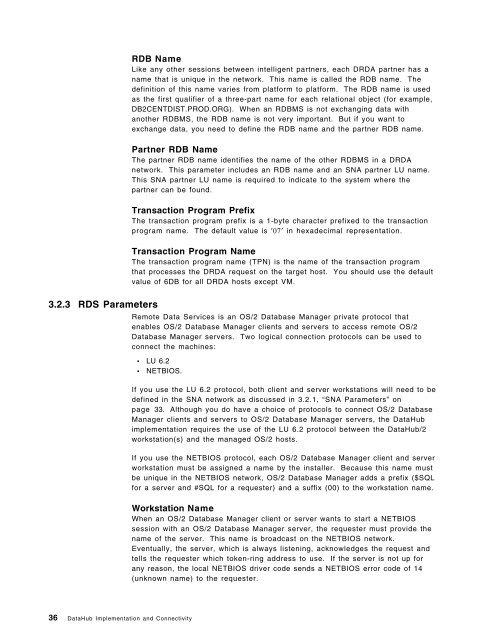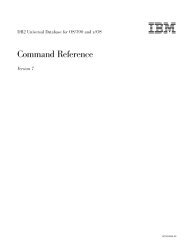International Technical Support Organization Database Systems ...
International Technical Support Organization Database Systems ...
International Technical Support Organization Database Systems ...
Create successful ePaper yourself
Turn your PDF publications into a flip-book with our unique Google optimized e-Paper software.
3.2.3 RDS Parameters<br />
RDB Name<br />
Like any other sessions between intelligent partners, each DRDA partner has a<br />
name that is unique in the network. This name is called the RDB name. The<br />
definition of this name varies from platform to platform. The RDB name is used<br />
as the first qualifier of a three-part name for each relational object (for example,<br />
DB2CENTDIST.PROD.ORG). When an RDBMS is not exchanging data with<br />
another RDBMS, the RDB name is not very important. But if you want to<br />
exchange data, you need to define the RDB name and the partner RDB name.<br />
Partner RDB Name<br />
The partner RDB name identifies the name of the other RDBMS in a DRDA<br />
network. This parameter includes an RDB name and an SNA partner LU name.<br />
This SNA partner LU name is required to indicate to the system where the<br />
partner can be found.<br />
Transaction Program Prefix<br />
The transaction program prefix is a 1-byte character prefixed to the transaction<br />
program name. The default value is ′07′ in hexadecimal representation.<br />
Transaction Program Name<br />
The transaction program name (TPN) is the name of the transaction program<br />
that processes the DRDA request on the target host. You should use the default<br />
value of 6DB for all DRDA hosts except VM.<br />
Remote Data Services is an OS/2 <strong>Database</strong> Manager private protocol that<br />
enables OS/2 <strong>Database</strong> Manager clients and servers to access remote OS/2<br />
<strong>Database</strong> Manager servers. Two logical connection protocols can be used to<br />
connect the machines:<br />
• LU 6.2<br />
• NETBIOS.<br />
36 DataHub Implementation and Connectivity<br />
If you use the LU 6.2 protocol, both client and server workstations will need to be<br />
defined in the SNA network as discussed in 3.2.1, “SNA Parameters” on<br />
page 33. Although you do have a choice of protocols to connect OS/2 <strong>Database</strong><br />
Manager clients and servers to OS/2 <strong>Database</strong> Manager servers, the DataHub<br />
implementation requires the use of the LU 6.2 protocol between the DataHub/2<br />
workstation(s) and the managed OS/2 hosts.<br />
If you use the NETBIOS protocol, each OS/2 <strong>Database</strong> Manager client and server<br />
workstation must be assigned a name by the installer. Because this name must<br />
be unique in the NETBIOS network, OS/2 <strong>Database</strong> Manager adds a prefix ($SQL<br />
for a server and #SQL for a requester) and a suffix (00) to the workstation name.<br />
Workstation Name<br />
When an OS/2 <strong>Database</strong> Manager client or server wants to start a NETBIOS<br />
session with an OS/2 <strong>Database</strong> Manager server, the requester must provide the<br />
name of the server. This name is broadcast on the NETBIOS network.<br />
Eventually, the server, which is always listening, acknowledges the request and<br />
tells the requester which token-ring address to use. If the server is not up for<br />
any reason, the local NETBIOS driver code sends a NETBIOS error code of 14<br />
(unknown name) to the requester.





